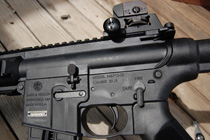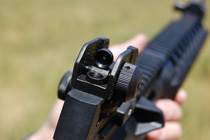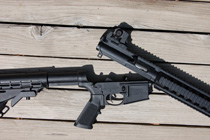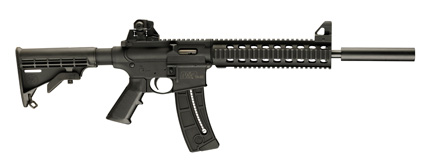The wickedest-looking .22 I’ve seen is the M&P15-22 Smith & Wesson introduced in early 2009. Several M&P rifles were at hand, but the biggest crowd gathered around the new rimfire version of the Military & Police centerfire rifles.
The remarkable thing about the new .22 LR was that it was the exact spit and image of all the “grown-up” M&P rifles on display. The resemblance was remarkable, particularly since the M&P15-22 was advertised as weighing just 5.5 pounds, including magazine. That’s roughly 40 percent less than many centerfire M&P15 or AR-15 rifles weigh, even without their magazines.
 Gun Details
Gun Details
This remarkable weight reduction is made possible by the use of high-strength polymer in manufacturing the new rimfire. This material is used extensively throughout rifle: upper and lower receiver, forend, stock, trigger, handguard, both front and rear sights, and magazine. You name it, and it’s probably polymer. The bolt, barrel and springs are made of steel, but not much else on this rifle is. If you weren’t aware of this, you’d swear the entire rifle was fabricated of steel.
Advertisement — Continue Reading Below
The magazine is the first clue to the rifle’s rimfire diet. While it superficially resembles a 5.56mm magazine, its exposed spring and the legend “22 LR” molded into its right side are dead giveaways. The magazine holds 25 rounds, and was 100 percent reliable with everything I fed it, ranging from high-velocity hollowpoints and standard-velocity target fodder to the light-bullet ultra-velocity loads that are often problematic. This is the first curved, high-capacity .22 magazine I’ve found to be trouble-free.
Another giveaway is the absence of a forward-assist plunger. In its place is a stationary projection immediately behind the ejection port. I guess this is for the benefit of AR-15 aficionados who automatically stab the forward assist every time they slap a new magazine in. The projection gives the shooter’s thumb someplace to go when he or she reaches for the forward assist. A forward-assist plunger isn’t necessary because the M&P15-22 isn’t gas-operated like its larger brothers are. Simple blowback operation works fine on rimfire autoloaders. The forward assist wasn’t part of the original centerfire design, but was added later to correct reliability problems with early AR autoloaders.
While they’re designed for combat, AR-15s firing .223 ammo are a varmint hunter’s delight. Many are accurate at extended range, and their gas-operated actions sufficiently reduce felt recoil that you can spot bullet strikes. They also make great plinking rifles if not for the high price of ammo you have to feed them.
Advertisement — Continue Reading Below
Now imagine an AR-15 way lighter than you’re accustomed to, which fires low-cost .22 LR ammo. It has the same looks, feel, and tack-driving accuracy, and you can shoot it all day without denting the budget. After giving it a serious workout, my sons and grandsons agree S&W’s new M&P15-22 is even more fun than centerfire AR-15s can be.
That, in a nutshell, is what you get with Smith & Wesson’s M&P15-22. It’s an M&P15 in every detail but weight and the ammunition it digests. Another surprise is the price of just $499.
According to Tom Kelley, Smith & Wesson’s vice president of marketing, the new M&P15-22 “was intended to provide fans of the AR-15, as well as law enforcement and military professionals a lightweight, yet durable rifle with operating controls that function identically to other M&P15 rifles, but fires low-cost .22 LR ammunition,” He added that, “The rimfire M&P15-22 provides sport shooters and working professionals an opportunity to practice and train without the higher cost and scarcity of .223 ammunition.”
Advertisement — Continue Reading Below
The rimfire’s A3 upper receiver sports a ventilated handguard with Picatinny-style rails on the top, bottom and along both sides. This allows mounting a variety of accessories—optical sights, high-intensity lights, bipods, whatever—in just about any position you like. The top rail is 15.5 inches in overall length, and accepts any Mil-Std-1913 Military Stand-ard rail-adaptable accessory.
The A2-style rear sight supplied is fully adjustable, and includes a pair of built-in apertures that pivot to give you the choice of a small-diameter tar-get aperture for long-range shooting, or a considerably wider combat aperture for hunting or plinking. Shooters unfamiliar with aperture or “peep” sights often opt for the smaller opening, reasoning it offers superior accuracy.
 Sights
Sights
My aging eyes were handicapped by the small aperture, but did fine with the larger peep. The eye automatically centers the front sight at the strongest point of light, which happens to be at the center of the aperture. After learning to use a peep as a member of an ROTC rifle team, I began installing aperture sights on deer rifles many years ago. I mimicked the effect of today’s “ghost ring” sights by un-screwing the tiny target aperture and throwing it away. I sighted through the threaded, gaping hole that remained. Accuracy was good enough to drop one nice buck nearly 300 yards away, and the wide-open aperture was faster on target than any scope I’ve ever owned. I like a good optical sight, but would never sell aperture sights short.
Advertisement — Continue Reading Below
The rifle’s front sight is an A2-style post. Both front and rear sights can be quickly removed by unscrewing a knurled nut in the base of each sight. Mounting a red dot sight, Holosight or scope takes only a few seconds.
Simply squeezing a lever allows you to adjust the collapsible buttstock to six different lengths. The gun’s overall length is a compact 33.75 inches when the stock is fully extended. The A2 pistol grip can be easily and quickly replaced by any standard AR-style grip.
Operation
The Operation is basically identical to the procedure used in loading and firing a centerfire AR-15. Pulling the T-shaped charging handle at the back of the receiver reward retracts the bolt and cocks the action. Pressing a release located above the magazine on the port side of the receiver allows the bolt to move forward into battery.
Advertisement — Continue Reading Below
Owners of AR-15 and M&P15 centerfires will find the same controls in all the familiar places: the large, two-position safety above the pistol grip on left side of the receiver, and a magazine release located on the starboard side a half-inch above the triggerguard.
While the magazine outwardly resembles a centerfire M&P15 magazine, it encases a separate, smaller magazine that holds 25 rounds of .22 LR ammunition in single-stack configuration. A loading button projecting from either side lets you compress the spring with your thumb for easier loading. A bright orange follower is visible through the ejection port when the magazine runs dry, causing the bolt to lock in the open position.
The S&W M&P15-22 can be field stripped the same way AR-15 centerfires are broken down for cleaning. No tools are needed, although it’s good to have a ballpoint pen or a similar object handy to start the takedown pin moving to the right. The owner’s manual is extremely helpful with easy-to-follow photo-illustrated instructions for disassembly and cleaning. The manual even shows how to disassemble the magazine. Most autoloader malfunctions can be traced to dirty or damaged magazines, so it’s good to know how to maintain them.
Advertisement — Continue Reading Below
 Shooting Impressions
Shooting Impressions
I was pleasantly surprised at the accuracy the little gun proved capable of. When I fired the M&P15-22 from a rest at 50 yards, it delivered five-shot groups measuring from 1.38 inches to just 0.75 of an inch between centers. Federal Gold Match loads produced the best accuracy. Using a good scope or red-dot sight may have resulted in even smaller groups.
While the trigger was on the mushy side, it broke nicely under just 6.5 pounds of pressure. The rifle flawlessly fed and fired a variety of .22 LR ammo. After making sure the rifle was properly zeroed, I took it to the nearby desert. I decided the M&P15-22 would make an ideal rabbit rifle, and set out to test this theory.
I began hunting in early morning, before the August sun could crank the temperature too high. Jackrabbits were thin on the ground, but I finally flushed one from behind a clump of sagebrush some 40 yards away. I waited a couple of seconds for him to stop and look back at me, but it never happened. By the time I dropped him, he’d doubled the distance between us and never stopped moving. By the time a 40-grain bullet struck home, I was grateful for the 25-shot magazine.
Advertisement — Continue Reading Below
It took me over an hour to find another long-eared target. This jack moved even faster, bounding away through the sage like a miniature, supercharged kangaroo. I fired three times before finally connecting, not a stellar demonstration of marksmanship, but running targets a half football field away aren’t easy to hit.
I walked the fast-warming desert for another hour before calling it quits. I was hot, tired and ready to return to my air-conditioned car. The light, handy little .22 LR was a delight to carry and a lot of fun to shoot.
While I try hard to find something to criticize about any new rifle I test, I admit to being smitten by Smith & Wesson’s M&P15-22 rimfire. I give it five stars, thumbs up, or top dog on whatever ranking system you choose. When the consignment period expires and it’s time to return the rifle, I’ll probably write a check instead. You can find out more at smith-wesson.com or call them at 800-331-0852.
Advertisement — Continue Reading Below























